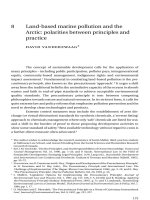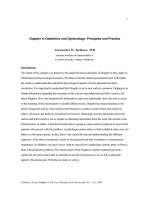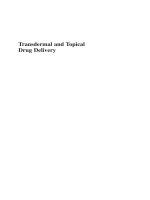SYSTEMS ENGINEERING PRINCIPLES AND PRACTICE
Bạn đang xem bản rút gọn của tài liệu. Xem và tải ngay bản đầy đủ của tài liệu tại đây (3.82 MB, 559 trang )
SYSTEMS ENGINEERING
PRINCIPLES AND
PRACTICE
SECOND EDITION
Alexander Kossiakoff
William N. Sweet
Samuel J. Seymour
Steven M. Biemer
A JOHN WILEY & SONS, INC. PUBLICATION
ffirs02.indd iiiffirs02.indd iii 2/8/2011 11:05:45 AM2/8/2011 11:05:45 AM
ffirs04.indd viffirs04.indd vi 2/8/2011 11:05:47 AM2/8/2011 11:05:47 AM
SYSTEMS
ENGINEERING
PRINCIPLES AND
PRACTICE
ffirs.indd iffirs.indd i 2/8/2011 11:05:44 AM2/8/2011 11:05:44 AM
WILEY SERIES IN SYSTEMS ENGINEERING
AND MANAGEMENT
Andrew P. Sage, Editor
A complete list of the titles in this series appears at the end of this volume.
ffirs01.indd iiffirs01.indd ii 2/8/2011 11:05:44 AM2/8/2011 11:05:44 AM
SYSTEMS ENGINEERING
PRINCIPLES AND
PRACTICE
SECOND EDITION
Alexander Kossiakoff
William N. Sweet
Samuel J. Seymour
Steven M. Biemer
A JOHN WILEY & SONS, INC. PUBLICATION
ffirs02.indd iiiffirs02.indd iii 2/8/2011 11:05:45 AM2/8/2011 11:05:45 AM
Copyright © 2011 by John Wiley & Sons, Inc. All rights reserved.
Published by John Wiley & Sons, Inc., Hoboken, New Jersey
Published simultaneously in Canada
No part of this publication may be reproduced, stored in a retrieval system, or transmitted in any form or
by any means, electronic, mechanical, photocopying, recording, scanning, or otherwise, except as
permitted under Section 107 or 108 of the 1976 United States Copyright Act, without either the prior
written permission of the Publisher, or authorization through payment of the appropriate per-copy fee
to the Copyright Clearance Center, Inc., 222 Rosewood Drive, Danvers, MA 01923, (978) 750-8400,
fax (978) 750-4470, or on the web at www.copyright.com. Requests to the Publisher for permission
should be addressed to the Permissions Department, John Wiley & Sons, Inc., 111 River Street, Hoboken,
NJ 07030, (201) 748-6011, fax (201) 748-6008, or online at />Limit of Liability/Disclaimer of Warranty: While the publisher and author have used their best efforts in
preparing this book, they make no representations or warranties with respect to the accuracy or
completeness of the contents of this book and specifi cally disclaim any implied warranties of
merchantability or fi tness for a particular purpose. No warranty may be created or extended by sales
representatives or written sales materials. The advice and strategies contained herein may not be suitable
for your situation. You should consult with a professional where appropriate. Neither the publisher nor
author shall be liable for any loss of profi t or any other commercial damages, including but not limited to
special, incidental, consequential, or other damages.
For general information on our other products and services or for technical support, please contact our
Customer Care Department within the United States at (800) 762-2974, outside the United States at
(317) 572-3993 or fax (317) 572-4002.
Wiley also publishes its books in a variety of electronic formats. Some content that appears in print may
not be available in electronic formats. For more information about Wiley products, visit our web site at
www.wiley.com.
Library of Congress Cataloging-in-Publication Data:
Systems engineering : principles and practice/Alexander Kossiakoff [et al.].—2nd ed.
p. cm.—(Wiley series in systems engineering and management; 67)
Rev. ed. of: Systems engineering: principles and practices/Alexander
Kossiakoff, William N. Sweet. 2003.
ISBN 978-0-470-40548-2 (hardback)
1. Systems engineering. I. Kossiakoff, Alexander, 1945– II. Title.
TA168.K68 2010
620.001′171–dc22
2010036856
Printed in the United States of America
oBook ISBN: 9781118001028
ePDF ISBN: 9781118001011
ePub ISBN: 9781118009031
10 9 8 7 6 5 4 3 2 1
ffirs03.indd ivffirs03.indd iv 2/8/2011 11:05:46 AM2/8/2011 11:05:46 AM
To Alexander Kossiakoff,
who never took “ no ” for an answer and refused to believe that anything was
impossible. He was an extraordinary problem solver, instructor, mentor, and
friend.
Samuel J. Seymour
Steven M. Biemer
ffirs04.indd vffirs04.indd v 2/8/2011 11:05:47 AM2/8/2011 11:05:47 AM
ffirs04.indd viffirs04.indd vi 2/8/2011 11:05:47 AM2/8/2011 11:05:47 AM
LIST OF ILLUSTRATIONS xiii
LIST OF TABLES xvii
PREFACE TO THE SECOND EDITION xix
PREFACE TO THE FIRST EDITION xxiii
PART I FOUNDATIONS OF SYSTEMS ENGINEERING 1
1 SYSTEMS ENGINEERING AND THE WORLD OF MODERN
SYSTEMS 3
1.1 What Is Systems Engineering? 3
1.2 Origins of Systems Engineering 5
1.3 Examples of Systems Requiring Systems Engineering 10
1.4 Systems Engineering as a Profession 12
1.5 Systems Engineer Career Development Model 18
1.6 The Power of Systems Engineering 21
1.7 Summary 23
Problems 25
Further Reading 26
2 SYSTEMS ENGINEERING LANDSCAPE 27
2.1 Systems Engineering Viewpoint 27
2.2 Perspectives of Systems Engineering 32
2.3 Systems Domains 34
2.4 Systems Engineering Fields 35
2.5 Systems Engineerng Approaches 36
2.6 Systems Engineering Activities and Products 37
2.7 Summary 38
Problems 39
Further Reading 40
CONTENTS
vii
ftoc.indd viiftoc.indd vii 2/8/2011 11:05:50 AM2/8/2011 11:05:50 AM
viii CONTENTS
3 STRUCTURE OF COMPLEX SYSTEMS 41
3.1 System Building Blocks and Interfaces 41
3.2 Hierarchy of Complex Systems 42
3.3 System Building Blocks 45
3.4 The System Environment 51
3.5 Interfaces and Interactions 58
3.6 Complexity in Modern Systems 60
3.7 Summary 64
Problems 66
Further Reading 67
4 THE SYSTEM DEVELOPMENT PROCESS 69
4.1 Systems Engineering through the System Life Cycle 69
4.2 System Life Cycle 70
4.3 Evolutionary Characteristics of the Development Process 82
4.4 The Systems Engineering Method 87
4.5 Testing throughout System Development 103
4.6 Summary 106
Problems 108
Further Reading 109
5 SYSTEMS ENGINEERING MANAGEMENT 111
5.1 Managing System Development and Risks 111
5.2 WBS 113
5.3 SEMP 117
5.4 Risk Management 120
5.5 Organization of Systems Engineering 128
5.6 Summary 132
Problems 133
Further Reading 134
PART II CONCEPT DEVELOPMENT STAGE 137
6 NEEDS ANALYSIS 139
6.1 Originating a New System 139
6.2 Operations Analysis 146
6.3 Functional Analysis 151
6.4 Feasibility Defi nition 153
ftoc.indd viiiftoc.indd viii 2/8/2011 11:05:50 AM2/8/2011 11:05:50 AM
CONTENTS ix
6.5 Needs Validation 155
6.6 System Operational Requirements 158
6.7 Summary 162
Problems 163
Further Reading 164
7 CONCEPT EXPLORATION 165
7.1 Developing the System Requirements 165
7.2 Operational Requirements Analysis 170
7.3 Performance Requirements Formulation 178
7.4 Implementation of Concept Exploration 185
7.5 Performance Requirements Validation 189
7.6 Summary 191
Problems 193
Further Reading 194
8 CONCEPT DEFINITION 197
8.1 Selecting the System Concept 197
8.2 Performance Requirements Analysis 201
8.3 Functional Analysis and Formulation 206
8.4 Functional Allocation 212
8.5 Concept Selection 214
8.6 Concept Validation 217
8.7 System Development Planning 219
8.8 Systems Architecting 222
8.9 System Modeling Languages: Unifi ed Modeling Language
(UML) and Systems Modeling Language (SysML) 228
8.10 Model-Based Systems Engineering (MBSE) 243
8.11 System Functional Specifi cations 246
8.12 Summary 247
Problems 250
Further Reading 252
9 DECISION ANALYSIS AND SUPPORT 255
9.1 Decision Making 256
9.2 Modeling throughout System Development 262
9.3 Modeling for Decisions 263
9.4 Simulation 272
ftoc.indd ixftoc.indd ix 2/8/2011 11:05:50 AM2/8/2011 11:05:50 AM
x CONTENTS
9.5 Trade-Off Analysis 282
9.6 Review of Probability 295
9.7 Evaluation Methods 299
9.8 Summary 308
Problems 311
Further Reading 312
PART III ENGINEERING DEVELOPMENT STAGE 315
10 ADVANCED DEVELOPMENT 317
10.1 Reducing Program Risks 317
10.2 Requirements Analysis 322
10.3 Functional Analysis and Design 327
10.4 Prototype Development as a Risk Mitigation Technique 333
10.5 Development Testing 340
10.6 Risk Reduction 349
10.7 Summary 350
Problems 352
Further Reading 354
11 SOFTWARE SYSTEMS ENGINEERING 355
11.1 Coping with Complexity and Abstraction 356
11.2 Nature of Software Development 360
11.3 Software Development Life Cycle Models 365
11.4 Software Concept Development: Analysis and Design 373
11.5 Software Engineering Development: Coding and Unit Test 385
11.6 Software Integration and Test 393
11.7 Software Engineering Management 396
11.8 Summary 402
Problems 405
Further Reading 406
12 ENGINEERING DESIGN 409
12.1 Implementing the System Building Blocks 409
12.2 Requirements Analysis 414
12.3 Functional Analysis and Design 416
12.4 Component Design 419
12.5 Design Validation 432
ftoc.indd xftoc.indd x 2/8/2011 11:05:50 AM2/8/2011 11:05:50 AM
CONTENTS xi
12.6 CM 436
12.7 Summary 439
Problems 441
Further Reading 442
13 INTEGRATION AND EVALUATION 443
13.1 Integrating, Testing, and Evaluating the Total System 443
13.2 Test Planning and Preparation 450
13.3 System Integration 455
13.4 Developmental System Testing 462
13.5 Operational Test and Evaluation 467
13.6 Summary 475
Problems 478
Further Reading 478
PART IV POSTDEVELOPMENT STAGE 481
14 PRODUCTION 483
14.1 Systems Engineering in the Factory 483
14.2 Engineering for Production 485
14.3 Transition from Development to Production 489
14.4 Production Operations 492
14.5 Acquiring a Production Knowledge Base 497
14.6 Summary 500
Problems 502
Further Reading 503
15 OPERATIONS AND SUPPORT 505
15.1 Installing, Maintaining, and Upgrading the System 505
15.2 Installation and Test 507
15.3 In-Service Support 512
15.4 Major System Upgrades: Modernization 516
15.5 Operational Factors in System Development 520
15.6 Summary 522
Problems 523
Further Reading 524
INDEX 525
ftoc.indd xiftoc.indd xi 2/8/2011 11:05:50 AM2/8/2011 11:05:50 AM
ftoc.indd xiiftoc.indd xii 2/8/2011 11:05:50 AM2/8/2011 11:05:50 AM
xiii
1.1 Career opportunities and growth 14
1.2a Technical orientation phase diagram 16
1.2b Technical orientation population density distribution 16
1.3a Systems engineering (SE) career elements derived from quality work
experiences 19
1.3b Components of employer development of systems engineers 19
1.4 “ T ” model for systems engineer career development 20
2.1a Performance versus cost 29
2.1b Performance/cost versus cost 29
2.2 The ideal missile design from the viewpoint of various specialists 31
2.3 The dimensions of design, systems engineering, and project planning
and control 32
2.4 Systems engineering domains 34
2.5 Examples of systems engineering fi elds 35
2.6 Examples of systems engineering approaches 36
2.7 Life cycle systems engineering view 37
3.1 Knowledge domains of systems engineer and design specialist 45
3.2 Context diagram 53
3.3 Context diagram for an automobile 54
3.4 Environments of a passenger airliner 56
3.5 Functional interactions and physical interfaces 59
3.6 Pyramid of system hierarchy 63
4.1 DoD system life cycle model 71
4.2 System life cycle model 72
4.3 Principal stages in system life cycle 75
4.4 Concept development phases of system life cycle 76
4.5 Engineering development phases in system life cycle 78
4.6 Principal participants in a typical aerospace system development 86
4.7 DoD MIL - STD499B 90
4.8 IEEE - 1220 systems engineering process 90
4.9 EIA - 632 systems engineering process 91
LIST OF ILLUSTRATIONS
fbetw01.indd xiiifbetw01.indd xiii 2/9/2011 6:29:47 PM2/9/2011 6:29:47 PM
xiv LIST OF ILLUSTRATIONS
4.10 ISO - 15288 Systems engineering process 92
4.11 Systems engineering method top - level fl ow diagram 92
4.12 Systems engineering method fl ow diagram 94
4.13 Spiral model of the defense system life cycle 104
5.1 Systems engineering as a part of project management 112
5.2 Place of SEMP in program management plans 118
5.3 Variation of program risk and effort throughout system development 121
5.4 Example of a risk mitigation waterfall chart 122
5.5 An example of a risk cube display 124
6.1 Needs analysis phase in the system life cycle 140
6.2 Needs analysis phase fl ow diagram 147
6.3 Objectives tree structure 150
6.4 Example objectives tree for an automobile 151
6.5 Analysis pyramid 156
7.1 Concept exploration phase in system life cycle 166
7.2 Concept exploration phase fl ow diagram 170
7.3 Simple requirements development process 171
7.4 Triumvirate of conceptual design 175
7.5 Hierarchy of scenarios 177
7.6 Function category versus functional media 181
8.1 Concept defi nition phase in system life cycle 198
8.2 Concept defi nition phase fl ow diagram 202
8.3 IDEF0 functional model structure 208
8.4 Functional block diagram of a standard coffeemaker 210
8.5 Traditional view of architecture 223
8.6 DODAF version 2.0 viewpoints 227
8.7 UML models 229
8.8 Use case diagram 231
8.9 UML activity diagram 233
8.10 UML sequence diagram 234
8.11 Example of a class association 235
8.12 Example of a class generalization association 236
8.13 Class diagram of the library check - out system 237
8.14 SysML models 237
8.15 SysML requirements diagram 238
8.16 SysML block defi nition 240
8.17 SysML block associations 241
8.18a SysML functional hierarchy tree 242
8.18b SysML activity diagram 242
8.19 Baker ’ s MDSD subprocesses 244
8.20 Baker ’ s information model for MDSD 244
9.1 Basic decision - making process 256
9.2 Traditional hierarchical block diagram 265
9.3 Context diagram of a passenger aircraft 266
9.4 Air defense functional fl ow block diagram 267
fbetw01.indd xivfbetw01.indd xiv 2/9/2011 6:29:47 PM2/9/2011 6:29:47 PM
LIST OF ILLUSTRATIONS xv
9.5 System effectiveness simulation 275
9.6 Hardware - in - the - loop simulation 277
9.7 Virtual reality simulation 280
9.8 Candidate utility functions 289
9.9 Criteria profi le 290
9.10 Union of two events 297
9.11 Conditional events 297
9.12 AHP example 300
9.13 AHP results 301
9.14 Decision tree example 302
9.15 Decision path 302
9.16 Decision tree solved 303
9.17 Utility function 304
9.18 Decision tree solved with a utility function 304
9.19 Example of cost - effectiveness integration 305
9.20 QFD house of quality 307
10.1 Advanced development phase in system life cycle 318
10.2 Advanced development phase fl ow diagram 321
10.3 Test and evaluation process of a system element 345
11.1 IEEE software systems engineering process 357
11.2 Software hierarchy 359
11.3 Notional 3 - tier architecture 359
11.4 Classical waterfall software development cycle 367
11.5 Software incremental model 369
11.6 Spiral model 370
11.7 State transition diagram in concurrent development model 371
11.8 User needs, software requirements and specifi cations 376
11.9 Software generation process 376
11.10 Principles of modular partitioning 379
11.11 Functional fl ow block diagram example 381
11.12 Data fl ow diagram: library checkout 381
11.13 Robustness diagram: library checkout 384
12.1 Engineering design phase in system life cycle 410
12.2 Engineering design phase in relation to integration and evaluation 411
12.3 Engineering design phase fl ow diagram 413
13.1 Integration and evaluation phase in system life cycle 445
13.2 Integration and evaluation phase in relation to engineering design 445
13.3 System test and evaluation team 446
13.4 System element test confi guration 456
13.5 Subsystems test confi guration 459
13.6a Operation of a passenger airliner 469
13.6b Operational testing of an airliner 469
13.7 Test realism versus cost 471
14.1 Production phase in system life cycle 484
14.2 Production phase overlap with adjacent phases 485
fbetw01.indd xvfbetw01.indd xv 2/9/2011 6:29:47 PM2/9/2011 6:29:47 PM
xvi LIST OF ILLUSTRATIONS
14.3 Production operation system 494
15.1 Operations and support phase in system life cycle 506
15.2 System operations history 507
15.3 Non - disruptive installation via simulation 510
15.4 Non - disruptive installation via a duplicate system 511
fbetw01.indd xvifbetw01.indd xvi 2/9/2011 6:29:47 PM2/9/2011 6:29:47 PM
xvii
1.1 Examples of Engineered Complex Systems: Signal and Data Systems 11
1.2 Examples of Engineered Complex Systems: Material and Energy
Systems 11
2.1 Comparison of Systems Perspectives 33
2.2 Systems Engineering Activities and Documents 38
3.1 System Design Hierarchy 43
3.2 System Functional Elements 47
3.3 Component Design Elements 49
3.4 Examples of Interface Elements 60
4.1 Evolution of System Materialization through the System Life Cycle 84
4.2 Evolution of System Representation 88
4.3 Systems Engineering Method over Life Cycle 102
5.1 System Product WBS Partial Breakdown Structure 114
5.2 Risk Likelihood 125
5.3 Risk Criticality 125
5.4 Sample Risk Plan Worksheet 128
6.1 Status of System Materialization at the Needs Analysis Phase 143
7.1 Status of System Materialization of the Concept Exploration Phase 168
8.1 Status of System Materialization of Concept Defi nition Phase 200
8.2 Use Case Example — “ Check - out Book ” 232
9.1 Decision Framework 259
9.2 Simon’s Decision Process 261
9.3 Weighted Sum Integration of Selection Criteria 288
9.4 Weighted Sum of Actual Measurement 289
9.5 Weighted Sum of Utility Scores 290
9.6 Trade-Off Matrix Example 293
10.1 Status of System Materialization at the Advanced Development Phase 320
10.2 Development of New Components 326
10.3 Selected Critical Characteristics of System Functional Elements 329
10.4 Some Examples of Special Materials 335
11.1 Software Types 361
LIST OF TABLES
fbetw02.indd xviifbetw02.indd xvii 2/9/2011 6:29:55 PM2/9/2011 6:29:55 PM
xviii LIST OF TABLES
11.2 Categories of Software - Dominated Systems 362
11.3 Differences between Hardware and Software 364
11.4 Systems Engineering Life Cycle and the Waterfall Model 368
11.5 Commonly Used Computer Languages 387
11.6 Some Special - Purpose Computer Languages 388
11.7 Characteristics of Prototypes 390
11.8 Comparison of Computer Interface Modes 391
11.9 Capability Levels 398
11.10 Maturity Levels 399
12.1 Status of System Materialization at the Engineering Design Phase 412
12.2 Confi guration Baselines 437
13.1 Status of System Materialization at the Integration and Evaluation
Phase 448
13.2 System Integration and Evaluation Process 449
13.3 Parallels between System Development and Test and Evaluation
(T & E) Planning 451
fbetw02.indd xviiifbetw02.indd xviii 2/9/2011 6:29:55 PM2/9/2011 6:29:55 PM
xix
It is an incredible honor and privilege to follow in the footsteps of an individual who
had a profound infl uence on the course of history and the fi eld of systems engineering.
Since publication of the fi rst edition of this book, the fi eld of systems engineering has
seen signifi cant advances, including a signifi cant increase in recognition of the disci-
pline, as measured by the number of conferences, symposia, journals, articles, and
books available on this crucial subject. Clearly, the fi eld has reached a high level of
maturity and is destined for continued growth. Unfortunately, the fi eld has also seen
some sorrowful losses, including one of the original authors, Alexander Kossiakoff,
who passed away just 2 years after the publication of the book. His vision, innovation,
excitement, and perseverance were contagious to all who worked with him and he is
missed by the community. Fortunately, his vision remains and continues to be the
driving force behind this book. It is with great pride that we dedicate this second edition
to the enduring legacy of Alexander Ivanovitch Kossiakoff.
ALEXANDER KOSSIAKOFF, 1914 – 2005
Alexander Kossiakoff, known to so many as “ Kossy, ” gave shape and direction to the
Johns Hopkins University Applied Physics Laboratory as its director from 1969 to
1980. His work helped defend our nation, enhance the capabilities of our military,
pushed technology in new and exciting directions, and bring successive new genera-
tions to an understanding of the unique challenges and opportunities of systems engi-
neering. In 1980, recognizing the need to improve the training and education of technical
professionals, he started the master of science degree program at Johns Hopkins
University in Technical Management and later expanded it to Systems Engineering,
one of the fi rst programs of its kind.
Today, the systems engineering program he founded is the largest part - time gradu-
ate program in the United States, with students enrolled from around the world in
classroom, distance, and organizational partnership venues; it continues to evolve as
the fi eld expands and teaching venues embrace new technologies, setting the standard
for graduate programs in systems engineering. The fi rst edition of the book is the foun-
dational systems engineering textbook for colleges and universities worldwide.
PREFACE TO THE SECOND
EDITION
fpref01.indd xixfpref01.indd xix 2/8/2011 3:49:23 PM2/8/2011 3:49:23 PM
xx PREFACE TO THE SECOND EDITION
OBJECTIVES OF THE SECOND EDITION
Traditional engineering disciplines do not provide the training, education, and experi-
ence necessary to ensure the successful development of a large, complex system
program from inception to operational use. The advocacy of the systems engineering
viewpoint and the goal for the practitioners to think like a systems engineer are still
the major premises of this book.
This second edition of Systems Engineering Principles and Practice continues to
be intended as a graduate - level textbook for courses introducing the fi eld and practice
of systems engineering. We continue the tradition of utilizing models to assist students
in grasping abstract concepts presented in the book. The fi ve basic models of the fi rst
edition are retained, with only minor refi nements to refl ect current thinking. Additionally,
the emphasis on application and practice is retained throughout and focuses on students
pursuing their educational careers in parallel with their professional careers. Detailed
mathematics and other technical fi elds are not explored in depth, providing the greatest
range of students who may benefi t, nor are traditional engineering disciplines provided
in detail, which would violate the book ’ s intended scope.
The updates and additions to the fi rst edition revolve around the changes occurring
in the fi eld of systems engineering since the original publication. Special attention was
made in the following areas :
•
The Systems Engineer ’ s Career. An expanded discussion is presented on
the career of the systems engineer. In recent years, systems engineering
has been recognized by many companies and organizations as a separate fi eld,
and the position of “ systems engineer ” has been formalized. Therefore, we
present a model of the systems engineer ’ s career to help guide prospective
professionals.
•
The Systems Engineering Landscape. The only new chapter introduced in the
second edition is titled by the same name and reinforces the concept of the
systems engineering viewpoint. Expanded discussions of the implications of this
viewpoint have been offered.
•
System Boundaries. Supplemental material has been introduced defi ning and
expanding our discussion on the concept of the system boundary. Through the
use of the book in graduate - level education, the authors recognized an inherent
misunderstanding of this concept — students in general have been unable to rec-
ognize the boundary between the system and its environment. This area has been
strengthened throughout the book.
•
System Complexity. Signifi cant research in the area of system complexity is now
available and has been addressed. Concepts such as system of systems engineer-
ing, complex systems management, and enterprise systems engineering are intro-
duced to the student as a hierarchy of complexity, of which systems engineering
forms the foundation.
•
Systems Architecting. Since the original publication, the fi eld of systems archi-
tecting has expanded signifi cantly, and the tools, techniques, and practices of this
fpref01.indd xxfpref01.indd xx 2/8/2011 3:49:23 PM2/8/2011 3:49:23 PM
PREFACE TO THE SECOND EDITION xxi
fi eld have been incorporated into the concept exploration and defi nition chapters.
New models and frameworks for both traditional structured analysis and object -
oriented analysis techniques are described and examples are provided, including
an expanded description of the Unifi ed Modeling Language and the Systems
Modeling Language. Finally, the extension of these new methodologies, model -
based systems engineering, is introduced.
•
Decision Making and Support. The chapter on systems engineering decision
tools has been updated and expanded to introduce the systems engineering
student to the variety of decisions required in this fi eld, and the modern pro-
cesses, tools, and techniques that are available for use. The chapter has also been
moved from the original special topics part of the book.
•
Software Systems Engineering. The chapter on software systems engineering has
been extensively revised to incorporate modern software engineering techniques,
principles, and concepts. Descriptions of modern software development life
cycle models, such as the agile development model, have been expanded to
refl ect current practices. Moreover, the section on capability maturity models has
been updated to refl ect the current integrated model. This chapter has also been
moved out of the special topics part and introduced as a full partner of advanced
development and engineering design.
In addition to the topics mentioned above, the chapter summaries have been refor-
matted for easier understanding, and the lists of problems and references have been
updated and expanded. Lastly, feedback, opinions, and recommendations from graduate
students have been incorporated where the wording or presentation was awkward or
unclear.
CONTENT DESCRIPTION
This book continues to be used to support the core courses of the Johns Hopkins
University Master of Science in Systems Engineering program and is now a primary
textbook used throughout the United States and in several other countries. Many pro-
grams have transitioned to online or distance instruction; the second edition was written
with distance teaching in mind, and offers additional examples.
The length of the book has grown, with the updates and new material refl ecting
the expansion of the fi eld itself.
The second edition now has four parts:
•
Part I . The Foundation of Systems Engineering, consisting of Chapters 1 – 5 ,
describes the origins and structure of modern systems, the current fi eld of systems
engineering, the structured development process of complex systems, and the
organization of system development projects.
•
Part II . Concept Development, consisting of Chapters 6 – 9 , describes the early
stages of the system life cycle in which a need for a new system is demonstrated,
fpref01.indd xxifpref01.indd xxi 2/8/2011 3:49:23 PM2/8/2011 3:49:23 PM
xxii PREFACE TO THE SECOND EDITION
its requirements identifi ed, alternative implementations developed, and key
program and technical decisions made.
•
Part III . Engineering Development, consisting of Chapters 10 – 13 , describes the
later stages of the system life cycle, in which the system building blocks are
engineered (to include both software and hardware subsystems) and the total
system is integrated and evaluated in an operational environment.
•
Part IV . Postdevelopment, consisting of Chapters 14 and 15 , describes the roles
of systems in the production, operation, and support phases of the system life
cycle and what domain knowledge of these phases a systems engineer should
acquire.
Each chapter contains a summary, homework problems, and bibliography.
ACKNOWLEDGMENTS
The authors of the second edition gratefully acknowledge the family of Dr. Kossiakoff
and Mr. William Sweet for their encouragement and support of a second edition to the
original book. As with the fi rst edition, the authors gratefully acknowledge the many
contributions made by the present and past faculties of the Johns Hopkins University
Systems Engineering graduate program. Their sharp insight and recommendations on
improvements to the fi rst edition have been invaluable in framing this publication.
Particular thanks are due to E. A. Smyth for his insightful review of the manuscript.
Finally, we are exceedingly grateful to our families — Judy Seymour and Michele
and August Biemer — for their encouragement, patience, and unfailing support, even
when they were continually asked to sacrifi ce, and the end never seemed to be
within reach.
Much of the work in preparing this book was supported as part of the educational
mission of the Johns Hopkins University Applied Physics Laboratory.
Samuel J. Seymour
Steven M. Biemer
2010
fpref01.indd xxiifpref01.indd xxii 2/8/2011 3:49:23 PM2/8/2011 3:49:23 PM
xxiii
Learning how to be a successful systems engineer is entirely different from learning
how to excel at a traditional engineering discipline. It requires developing the ability
to think in a special way, to acquire the “ systems engineering viewpoint, ” and to make
the central objective the system as a whole and the success of its mission. The systems
engineer faces three directions: the system user ’ s needs and concerns, the project man-
ager ’ s fi nancial and schedule constraints, and the capabilities and ambitions of the
engineering specialists who have to develop and build the elements of the system. This
requires learning enough of the language and basic principles of each of the three
constituencies to understand their requirements and to negotiate balanced solutions
acceptable to all. The role of interdisciplinary leadership is the key contribution and
principal challenge of systems engineering and it is absolutely indispensable to the
successful development of modern complex systems.
1.1 OBJECTIVES
Systems Engineering Principles and Practice is a textbook designed to help students
learn to think like systems engineers. Students seeking to learn systems engineering
after mastering a traditional engineering discipline often fi nd the subject highly abstract
and ambiguous. To help make systems engineering more tangible and easier to grasp,
the book provides several models: (1) a hierarchical model of complex systems, showing
them to be composed of a set of commonly occurring building blocks or components;
(2) a system life cycle model derived from existing models but more explicitly related
to evolving engineering activities and participants; (3) a model of the steps in the
systems engineering method and their iterative application to each phase of the life
cycle; (4) a concept of “ materialization ” that represents the stepwise evolution of an
abstract concept to an engineered, integrated, and validated system; and (5) repeated
references to the specifi c responsibilities of systems engineers as they evolve during
the system life cycle and to the scope of what a systems engineer must know to perform
these effectively. The book ’ s signifi cantly different approach is intended to complement
the several excellent existing textbooks that concentrate on the quantitative and analyti-
cal aspects of systems engineering.
PREFACE TO THE FIRST EDITION
fpref02.indd xxiiifpref02.indd xxiii 2/8/2011 3:49:24 PM2/8/2011 3:49:24 PM









